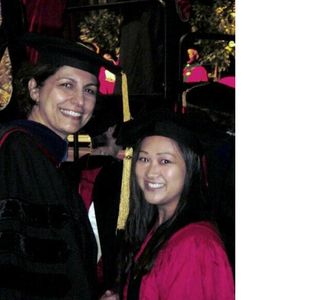Ivana Delalle. M.D., Ph.D
Associate Professor
Contact information
Email: idelalle@bu.edu
Tel. 617 414 7014
Education
- Pathology/Neuropathology residency/fellowship, Massachussets General Hospital, Harvard Medical School;
- M.D./ Ph.D, School of Medicine, University of Zagreb, Croatia
Research interests
1) Exosomal microRNA (miRNA, miR) as a Biomarker in Neuropsychiatric Diseases
My colleagues and I have recently shown that: 1) exosomes harbor differential microRNA (miR) expression in the postmortem brain tissue of patients diagnosed with either bipolar disorder (BD) or schizophrenia (SZ) in comparison to controls (#1); and 2) major cell-categories as well as distinct cortical areas’ exosomes from BD patients differ in specific miR expressions in comparison to controls. The currently submitted proposal is built on the central hypothesis supported by the accumulated preliminary data: miRs packaged into exosomes released from neuronal and glial cells into CSF and serum can be used as biomarkers because they represent a read-out of specific alterations in transcriptional regulation of the proteome in SZ and BD. We will use small RNA-Seq protocol developed by my colleagues, Drs. Andre Fischer and Anja Schneider in Goettingen, Germany, because this protocol yields reliable miRome from only 0.5 ng of RNA extracted from exosomes in clinically obtained serum and CSF samples. These colleagues, together with Dr. Thomas Schulze, internationally renowned expert in bipolar disorder, Dr. Vishwajit Nimgaonkar, a schizophrenia expert with over 20 years experience in international projects, Dr. Alexandra Dumitriu, a specialized RNA-Seq bioinformatician at Genome Science Institute at BUSM, and Boston University School of Public Health Professor and a leading US biostatistician, Dr. Howard Cabral, are the co-investigators.
2) Protein Expression of Alzheimer’s disease- and Reduced Hippocampal Volume- Risk Genetic Loci in Human Hippocampus
I have been working on this project with my colleague, Dr. Sudha Seshadri, BU Professor of Neurology and Framingham Hearth Study Senior Investigator, BU GMS students, Stephanie Adams and Tim Norman, and our Department’s expert histotechnologists Kathy Tilton and Teresa Lima. Aging is associated with the occurrence of Alzheimer’s disease (AD) and reduction in hippocampal volume. We have been examining the protein expression of novel genes implicated in both events using immunohistochemistry on paraffin-embedded postmortem hippocampal CA1 sections with no or mild-to-moderate AD-associated pathological changes, accompanied with the CDR (Clinical Dementia Rating) scale scores. Genome-wide association studies (GWAS) have established BIN1 as the most important AD susceptibility locus after APOE. We found BIN1 protein expressed strongly in CA1 glial somata of all the examined cases while the punctate signal in neuropil varied substantially. EPHA1, another confirmed AD risk locus, is an ephrin receptor implicated in brain-region specific apoptosis. We found EphA1 in the cytoplasm of neurons and glia, however, the quality of signal (homogeneous vs. granular) appeared to vary with AD changes. Methionine sulfoxide reductase B3 (MSRB3) locus, critical for oxidative stress, was identified GWAS studies on hippocampal volume. We found MSRB3 signal as discrete cytoplasmic puncta in CA1 pyramidal neurons from all of the examined cases, albeit in various amounts. We also examined the expression of LEMD3, a possible causal gene at the MSRB3 locus, and observed it in either some or virtually all CA1 neurons and glia, depending on the degree of AD changes. Further quantitative analysis of these distinctly expressed genes is underway to examine the correlation with cognitive decline.
3) 3D mapping of molecular Alzheimer’s pathology
Through collaboration with Tsai laboratory at MIT, Picower Institute for Learning and Memory, Brain and Cognitive Sciences Department, I have been participating in CLARITY protocol to map AD pathology in mouse and human brain. The initial findings will be presented in “Mechanisms of Neurodegeneration” conference in Heidelberg, Germany, in June 2015.
Selected Articles (graduate students in Delalle laboratory are underlined, or search additional publications in MyBibliography):
- Banigan MG, Kao PF (co-first author), Kozubek JA, Winslow AR, Medina J, Costa J, Schmitt A, Schneider A, Cabral H, Cagsal-Getkin O, Vanderburg CR, and Delalle I: Differential expression of exosomal miRNAs in prefrontal cortices of schizophrenia and bipolar disorder patients. PLoS One 2013; 8(1):e48814.doi:10.1371/journal.pone.0048814.
- Seo J, Giusti-Rodríguez P, Zhou Y, Rudenko A, Cho S, Ota KT, Park C, Patzke H, Madabhushi R, Pan L, Mungenast AE, Guan JS, Delalle I, Tsai LH. Activity-dependent p25 generation regulates synaptic plasticity and Aß-induced cognitive impairement. Cell 2014; 157(2):486-98. PMID: 24725413
- Kao PF, Banigan MG, Vanderburg CR, McKee AC, Polgar P, Seshadri S, and Delalle I: Increased expression of TrkB and Capzb2 accompanies preserved cognitive status in early Alzheimer’s disease pathology. J. Neuropathology Exp. Neurology 2012; 71(7):654-664.
- Agbemenyah HY, Agis-Balboa RC, Burkhardt S, Delalle I, Fischer A: Insulin growth factor binding protein 7 is a novel target to treat dementia. Neurobiol Dis 2013 Sep 25; 62C:135-143. doi: 10.1016/j.nbd.2013.09.011. PMID: 24075854.
- Graeff J, Guan J-S, Rei D, Wang W-Y, Hennig KM, Nieland TJF, Fass DJ, Kao PF, Kahn M, Joseph N, Haggarty SJ, Delalle I, and Tsai L-H: An epigenetic blockade of cognitive functions in the neurodegenerating brain. Nature 2012; 483:222-226.
- Bahri-Javan S, Maddalena A, Kerimoglu C, Wittnam J, Held T, Bahr M, Burkhardt S, Delalle I, Kugler S, Fischer A, and Sananbenesi F. HDAC1 regulates fear extinction in mice. J Neuroscience 2012; 32(15): 5062-73.
- 7. Zovoilis A, Agbemenyah HY, Agis-Balboa RC, Stilling RM , Rao P , Edbauer D, Farinelli L, Delalle I, Schmitt A, Falkai P, Bahari-Javan, S Burkhardt S , Sananbenesi F, and Fischer A: microRNA-34c is a novel target to treat dementias. The EMBO J 2011; 30(20):4299-308.
- Kao PF, Davis DA, Banigan MG, Vanderburg CR, Seshadri S, and Delalle I: Modulators of cytoskeletal reorganization in CA1 hippocampal neurons show increased expression in patients at mid-stage Alzheimer’s disease. PLoS One 2010 Oct 13;5(10):e13337.
- Davis DA, Wilson MH, Giraud J, Xie Z, Tseng H-C, England C, Hersckovitz H, Tsai L-H, and Delalle I: Capzb2 interacts with ß-tubulin to regulate growth cone morphology and neurite outgrowth. PLoS Biol 7(10) 2009; e1000208. doi:10.1371/journal.pbio.1000208.
